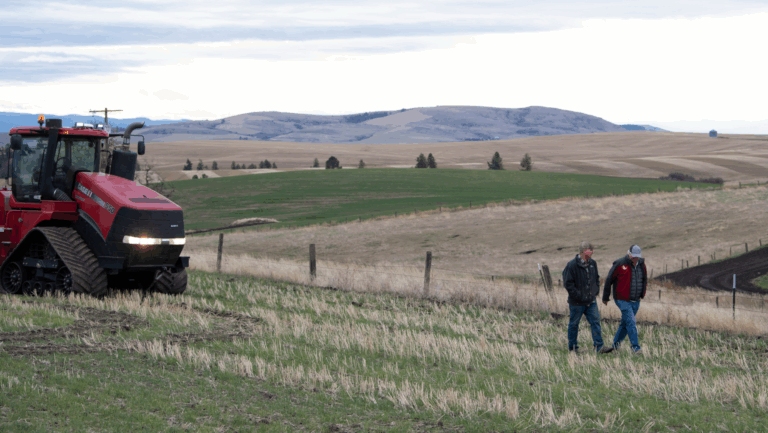Managing Heat Stress in Cattle
Recognize the signs of cattle heat stress and read firsthand tips to managing it.
As drought conditions persist across the western part of the U.S., heat stress poses a significant threat to cattle health and operational performance. In June 2022, thousands of cattle were lost from heat stress in Kansas. This event was devastating for the ranchers impacted and was a reminder of the importance of navigating this challenge together to protect our domestic food supply chain.
To learn more about how ranchers can effectively manage heat stress in cattle, we spoke with cattle rancher Brandi Buzzard. Brandi is a passionate advocate in her community and runs a cattle operation in Kansas alongside her husband and two daughters. She holds her undergraduate degrees in animal science and ag economics and a graduate degree in animal welfare and behavior from Kansas State University.
AgAmerica had the opportunity to sit down with Brandi and learn more about the signs of cattle heat stress, its impacts, and ways to manage it.
Signs of Heat Stress in Cattle
Heat stress occurs during abnormally hot conditions that cause an elevated body temperature in livestock. As a result, cattle are unable to regulate their body temperature, leading to health implications. It is important to note that humidity levels are a central contributor to heat stress in cattle. So, the combination of both hot temperatures and high dew points contributes to heat stress. Mild heat stress can begin around 72 degrees Fahrenheit with 50 percent humidity. When cattle are not acclimated to a humid climate, that can amplify the consequences of heat stress.
In order to effectively manage heat stress in cattle before it becomes too severe, it’s important to recognize the signs. Symptoms of heat stress include:
- Labored breathing;
- Elevated breathing rate;
- Restlessness;
- Drooling; and
- Elevated body temperature.
Impacts of Heat Stress in Cattle
There are various ways heat stress impacts cattle, with a possibility of animal fatality. Heat stress not only negatively impacts cattle health directly, but it also indirectly affects operational finances.
Reduced Caloric Intake
According to Brandi, generally, cattle do not eat as much when it is hot outside. As a result, they tend to eat in the mornings and the evenings but not during the hotter parts of the day. Reduced eating patterns can cause cows to produce less milk and reduce their ability to adequately feed calves. It can also prevent cattle from gaining necessary weight which, in turn, impacts the price ranchers receive per head.
Reduced Conception Rates
The reproductive performance of bulls and the birth weights of calves can also be negatively impacted by heat stress. Lower conception rates can last a month after heat stress was experienced. In addition, heat stress can lead to early embryonic loss.
Increased Disease Rates
Heat stress can cause higher disease rates such as lameness and impaired immune function. This ultimately puts cattle at a higher risk of health issues that can have significant impacts on your operation. Because the health of cattle is paramount to revenue generation, cattle diseases can be detrimental to your bottom line.
Ultimately, heat stress in cattle can lead to significant financial loss and negative operational performance—making prevention an essential part of risk management on your cattle ranch.
Three Steps to Manage Heat Stress in Cattle
Brandi recommends three essential methods for preventing heat stress in cattle. When considering how to manage cattle heat stress, early intervention is key.
1. Move Cattle During Cooler Times
It’s best to move cattle between pastures during cooler times of the day such as the morning and evening. When moving cattle, low-stress handling techniques are beneficial. This type of cattle handling involves making sure cattle are calm to preserve their health.
“Creating and managing movement is the key to the low-stress handling of cattle.”
Ron Gill, Texas Rancher
2. Provide Shade
It’s important to provide areas for cattle to rest in the shade to prevent overheating. Air flow and ventilation are also important. For instance, fans and open doors can keep air flowing in a barn. In addition, access to pasture with trees and open buildings is a great way to provide shade.
3. Provide Water for Drinking and Cooling
Not only is providing access to drinking water critical but providing access to water within the pastures for cattle to cool their bodies is also important. Making sure that the water is both cool and fresh and free of contaminants will ensure that the water is acceptable for drinking.
Being proactive and staying on top of cattle health makes all the difference. Taking steps to monitor cattle and manage heat stress can prevent strain on your cattle and your operation as a whole.
Be Proactive in Managing Cattle Heat Stress
You work hard every single day to protect the health of your cattle. But when disaster strikes, it’s important to have a support system that can help you get back on your feet. AgAmerica is dedicated to helping you sleep well during challenging times by providing resources and financing to help you protect the health of your cattle—and recover from herd loss if necessary.
Explore AgAmerica’s real estate-backed cattle loans to ensure your operation is prepared to handle the inevitable challenges that come along with ranching.






